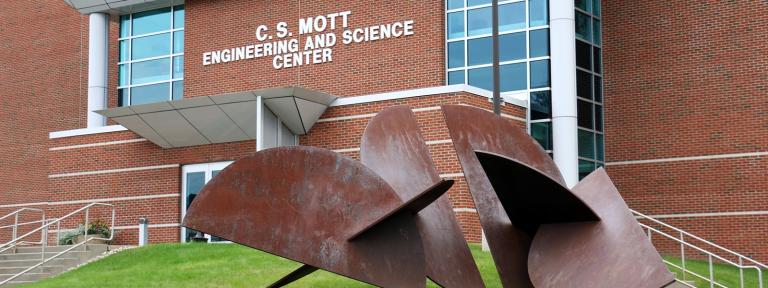
They giddily unpacked the items stuffed into the tailgate of the red Chevy pickup: the explosive devices; portable computer stand upon which the PC and flat screen monitor are bolted; cords and electrical outlets; camera stand; high speed digital video camera; and last but not least, one new plastic formed mailbox and one new aluminum mailbox.
As they hurriedly set up the equipment in the field behind the Sigma Alpha Epsilon house on Beecher Road in Flint, one student asked Dr. Kowalski, professor of Mechanical Engineering, if the police department was ok with their experiment.
"I called and described to them what we were doing," he said, adding that a small controlled detonation for the sake of scientific research was fine, as long as precautions were taken, such as maintaining a safe distant from the explosion point and conducting the test in an open field away from buildings and people.
The students-Senior Mechanical Engineering majors Pat Burns of Atlanta, Ga., Frances Wilson of Yorktown Heights, N.Y., Scott Darley of Millington, Mich., and Matt Branigan of Jackson, Mich.,-took Kowalski's MECH 514: Experimental Mechanics course this past winter term, which introduces students to strain measurement techniques and the importance of identifying and measuring physical quantities such as displacement, weight, load and temperatures during product testing and validation.
As part of the class, student teams must propose and administer a capstone project during the term. Burns, Wilson, Darley and Branigan decided to study what would happen to mailboxes if someone decided to blow them up, ala Unabomber style. They titled their project the Mailbox Integrity Test.
While some might view this idea as somewhat juvenile, there are serious implications related to this test that could help mailbox manufacturers better develop products that absorb the explosion instead of fragmenting into hundreds of flying pieces.
"Airbags in cars are manufactured with explosive charges," Kowalski said. "But when they are detonated, they open out without fragmenting. We think mailboxes could do the same thing under explosive conditions. As one can see on the slow motion video, when the black plastic-formed mailbox erupts, it fragments into hundreds of small, very sharp projectiles that could do some damage to the human body," he added.
At first, Kowalski thought the students weren't serious about blowing up mailboxes and video taping their work, but after fully describing their idea and the possible results obtained from their experiment, the professor agreed there was some merit to the exercise. As student Scott Darley described it, "we wanted to see how ordinary mailboxes people can buy everyday would respond. Would you buy a box if you knew it might fragment upon exploding, or purchase one that stays in one piece when detonated?"
Thus, they decided to use Kowalski's high speed digital video camera to video the exploding mailboxes. The camera, a FASTCAM-PCI Model 1KC, can shoot digital video in full color and capture how items come apart to test theories regarding the material integrity of products (click here to see a slow motion video of this experiment). To create the correct and safest explosive device, the students obtained two three-inch sections of PVC pipe and ordered black powder off of the internet. They also used an electrical detonator and battery to discharge the explosive at a significant, safe distance.
The students conducted two specific tests: one on the aluminum box, which fragmented into several large pieces and rose in the air more than 20 feet upon detonation; and one on a one-piece, plastic-formed mailbox, which fragmented into hundreds of small, sharp projectiles.
Although manufacturers do not design mailboxes to absorb and otherwise withstand these kinds of explosions, Kowalski observed that "it's clear what kind of danger these products present if someone decides to emulate the Unabomber, but take it a little further by having the device explode while in the box," he said. In a world where recent history shows that human beings are capable of doing just about anything out of desperation, bringing a little more safety to mailboxes might not seem so far-fetched.
And while the students were excited to see the effects of their project through the video captured by the high speed digital camera, they also realize that the technology used to deploy airbags could also be of value to mailbox manufacturers. This, according to Kowalski, is clearly evidenced on video replay.
"The multiple fracturing of the plastic mailbox and the convoluted distortion of the corrugated steel mailbox visibly demonstrates the unique failure mechanics of the two," he said. "Knowledge of how the current mailboxes respond to what is essentially an intense and instantaneous pressure is a valuable aid in the redesign of new boxes that would fail less catastrophically. Ideally, the mailboxes should contain as much of the bomb fragments as possible while just blowing open into the atmosphere - similar to the panel housing of an air bag in a steering wheel without fragments," he added.
Some words of wisdom to consider the next time readers open their mailboxes.
To learn more about the Experimental Mechanics laboratory, or to inquire about supporting the lab, please contact Dr. Henry Kowalski at (810) 762-9926.
Written by Gary J. Erwin
(810) 762-9538
gerwin@kettering.edu